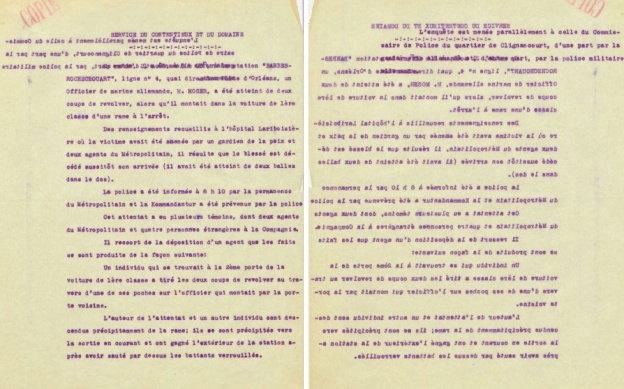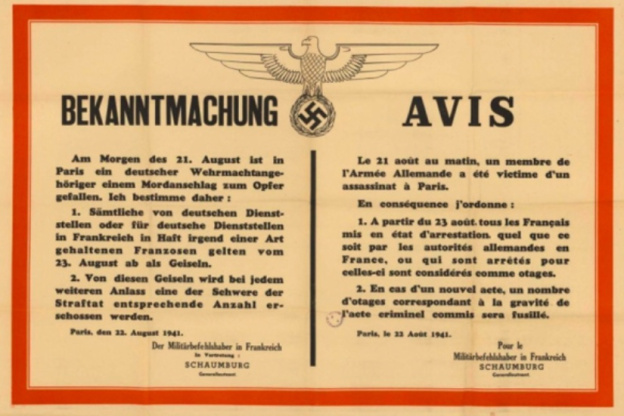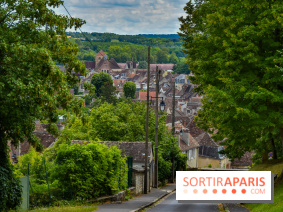On Thursday August 21, 1941, when Paris had been occupied by German troops for over a year , the Resistance carried out its first deadly attack against the invaders at the Barbès-Rochechouart metro station.
Since theGerman invasion of the Soviet Union in June 1941, Communists in France have been ordered tojoin the Resistance and take part in the fight against the Nazis through individual attacks on German officers. The aim was to force the Reich to keep its troops in France, so that they would not be sent to the Eastern Front, and thus help the USSR.
Despite the resistance and hesitation of some party members, some twenty young Communists trained in the Lardy forest during the summer of 1941, forming the Bataillons de la Jeunesse under the leadership ofAlbert Ouzoulias and Pierre Georges, the 22-year-old Communist activist and future Colonel Fabien.
The arrest by the Germans on August 13, 1941 of several young fighters - including Samuel Tyszelman, a close friend of Pierre Georges - during a demonstration in Strasbourg Saint-Denis, and their execution on August 19, prompted the Bataillons de la Jeunesse to take action in retaliation. The date of August 21 was chosen in reference toOperation Barbarossa, the Wehrmacht's invasion of the Soviet Union exactly two months earlier.
Due to the pronounced curvature of its platform, which offered numerous blind spots and the possibility of easy escape, the Barbès-Rochechouart metro station was chosen by Pierre Georges as the site of the planned attack on the enemy. The young Communists quickly dismissed the idea of simply pushing a German soldier onto the tracks as the subway train entered the station, so as to make the occupying troops understand that their action was deliberate and not accidental.
On August 21, 1941, Pierre Georges was reunited with his comrades Gilbert Brustlein, assigned to help him escape, and Robert Gueusquin and Fernand Zalkinow, assigned to observe and report, in Barbès-Rochechouart station. A few minutes later, Colonel Fabien shot twice a Kriegsmarine soldier, Alfons Moser, whose uniform reminded him of a high-ranking officer. He then fled in the company of his comrades-in-arms, while Alfons Moser died of internal bleeding.
In his book, Gilbert Brustlein describes the scene as follows. "A German in navy blue uniform came down the stairs and onto the quay, close to us. "You see, he's the one who's going to pay," Fabien whispers to me. The ticket inspector closes the entrance gate as the train enters the station. It stops, and the first car is in front of us. The doors open. The German enters the compartment, so Fabien rushes in behind him and holds out his 6.35. Two shots: bang, bang! I'm next to Fabien; I've drawn my gun to protect him. The German tries to turn towards me, staggers and collapses. Fabien turns and runs towards the exit staircase. I follow, still holding my 7.65 pointed forward to ward off any interception attempt against him. But there's no reaction on the platform, and he puts his gun away in his pocket [...] Almost at the top of the stairs, Fabien shouts "Stop him". [...] Then, seeing my gun pointed, a brave man tries to climb the banister to put a belt around me. [I dodged him and rushed towards the large swinging door through which Fabien had escaped. [...] I find him; he's been waiting for me in the large hall on the boulevard Barbès median strip. [...] We leave without haste [...] cross the boulevard and take rue Bervic [...] then set off in the direction of Square Willette. No one is chasing us, but Fabien picks up the pace and gets a few meters ahead of me [...] He exclaims: "Titi is avenged".
Following this attack, which marked the beginning of the Resistance's direct attacks on the occupying forces, the German authorities and the Vichy regime took immediate repressive measures; this was the beginning of the hostage policy. On August 23, Vichy set up a new court, the Sections Spéciales, to retry people convicted of minor offenses. The following day, three prisoners, imprisoned for distributing Communist leaflets, were falsely retried for terrorism and guillotined in the courtyard of the Santé prison, followed by three other Communists in September 1941.
Arrested in October 1941 and interrogated by the German and French police, the members of Gilbert Brustlein 's group gave up Brustlein's name as theperpetrator of the attack, but he escaped. It wasn't until November 30, 1942, whenColonel Fabien was arrested during a routine check at the République metro station, that the name of the real b omber became known to the authorities.
When questioned, Pierre Georges denounced himself to the French police, declaring: "The day after Gautherau (sic) was executed by the German authorities, I carried out on my own initiative an attack on a German midshipman. I did the shooting. I was accompanied by Brustlein. It took place in the Barbès-Rochechouart metro station on August 21, 1941.
Incarcerated at Fresnes prison and then at Fort de Romainville pending deportation, Colonel Fabien managed to escape in May 1943 and continued his fight against the invaders until his death in Habsheim, Alsace, on December 27, 1944, in a mine explosion.
Location
Barbès
2 Boulevard Marguerite de Rochechouart
75018 Paris 18
More information
Iconography: Top: © Archives départementales de Seine-et-Marne, SC51235/23 Photo no. 1: Report on the attack, Archives de la Préfecture de Police de Paris























